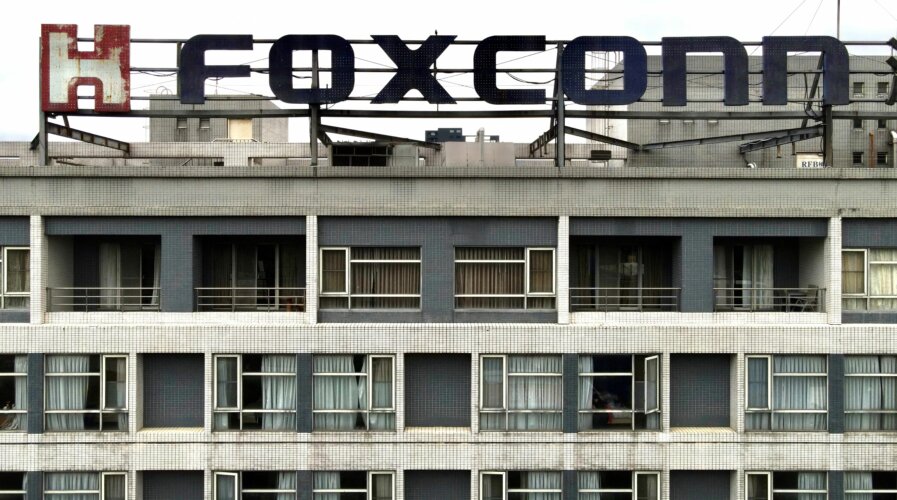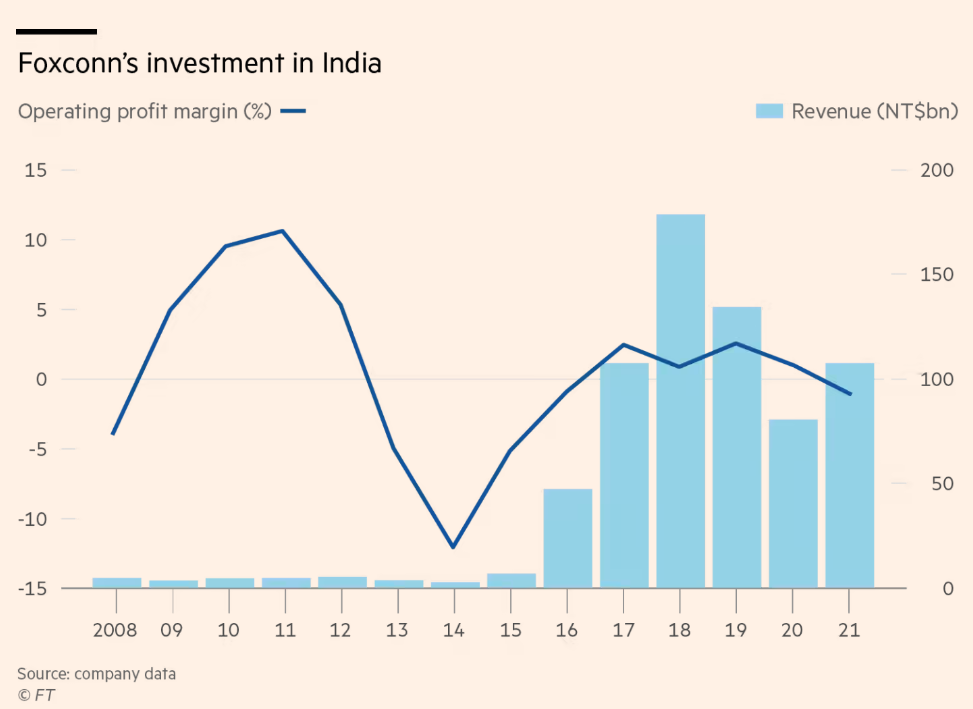
India is now the second-largest phone manufacturing country after China, with two billion ‘Made in India’ smartphones produced between 2014 and 2022.Source: Shutterstock
Foxconn: Cautious on sales and bullish in India
|
Getting your Trinity Audio player ready... |
- Foxconn chair Young Liu told investors the company expected to invest “several billion dollars” in India.
- Foxconn expects sales to fall in the current quarter and the year overall as expectations of a worsening market for electronics linger.
As more industry bellwethers announce their quarterly results, it is apparent that demand for electronic goods is slowing dramatically. Consumers worldwide are grappling with the realities of a largely post-pandemic world. Take Taiwan-based Foxconn, for instance, a significant manufacturer for consumer technology firms. Despite massive expansion plans in India, the company is finally feeling the brunt of a worsening demand.
Foxconn, formerly Hon Hai Precision Industry, is best known for its relationship with Apple, which relies on the Taiwanese company to produce and assemble its iPhone, among other products. Apple is also Foxconn’s top customer, and not too long after the former telegraphed its most extended sales slump in decades, the Taiwanese electronics manufacturer sees its sales falling quarterly and for the year overall.
After reporting a 1% drop in second-quarter net profit, Foxconn, the world’s largest contract electronics maker, said it anticipates that most of its main business segments will be in contraction for the year. According to the company’s statement, in the second quarter of 2023, revenue totaled NT$1.3045 trillion, down 14% on the year.
“Gross profit, at NT$83.6 billion, fell 14% at the same time; operating income was NT$30.9 billion, down 30%; while net profit fell 1% from a year ago to NT$33.0 billion,” Foxconn noted. The company reckons operating performance in the third quarter should warm up and show a trend of on-quarter growth.
“However, considering many external variables, in response to uncertainties such as global monetary tightening, geopolitical tensions, and inflation, the full-year outlook is now expected to decline from previous flattish expectations slightly,” Foxconn admitted.
As the South China Morning Post writer puts it, Foxconn’s results underscore expectations of a worsening market for global electronics as consumers and corporations hold off on spending during an economic downturn. To top it off, the company’s revenue could be affected by muted iPhone growth in 2023, according to Steven Tseng, analyst at Bloomberg Intelligence.
As it is, based on a report by Bloomberg, Apple is asking suppliers to produce about 85 million units of the iPhone 15 this year, roughly in line with the year before. The aim is to hold shipments steady despite tumult in the global economy and a projected decline in the overall smartphone market.
Foxconn in India

Foxconn Chairman and CEO Young Liu (L) greets Indian Prime Minister Narendra Modi (C), during SemiconIndia 2023, at Mahatma Mandir in Gandhinagar on July 28, 2023. (Photo by SAM PANTHAKY / AFP)
Over the last two years, Foxconn has had a renewed push in India, where it first invested 15 years ago. Today, India accounts for US$10 billion of Foxconn’s annual revenue, according to a presentation reviewed by the Financial Times. That makes up 4.6% of the company’s US$216 billion 2022 revenue, more than double the 2% registered in 2021.
So far, according to the internal presentation, Foxconn currently has nine campuses in India with 36 factories. Its operations are mainly concentrated in Tamil Nadu and Andhra Pradesh, producing smartphones, feature phones with fewer functions than smartphones, television sets, and set-top boxes for customers including Sony, Xiaomi, and Apple.

India now accounts for $10bn of Foxconn’s annual revenue. Source: Financial Times
In recent months the group has broken ground for a factory near Hyderabad, the capital of Telangana state, that government officials said would make smart headphones. It has also acquired land near the airport in the Karnataka capital Bengaluru for an iPhone plant. According to the internal Foxconn presentation, another site near Hyderabad and two more in Karnataka are in the planning stage.
Liu also told investors in the recent earnings call that the company expected to invest “several billion dollars” in India and to start making critical components for consumer electronics and some electric vehicle components next year in Karnataka, Telangana, and Tamil Nadu, its largest existing iPhone assembly hub.
Liu also pointed out that since Foxconn entered India in 2005, its revenue, number of employees, and investment scale have grown exponentially. At present, it is mainly engaged in the ICT final assembly business. In the future, he said Foxconn will actively deploy work in key components to raise its competitiveness in India.
“In addition to existing operations in the Andhra Pradesh and Tamil Nadu states, Hon Hai will also deploy in Karnataka, Telangana, and other states. Hon Hai will plan to establish industrial parks and optimize the business environment regarding infrastructure, policies, and laws through close cooperation with central and local governments,” Foxconn said in the earnings statement.
Outside of India, Lai said Foxconn will continue to implement the build-operate-localize (BOL) strategy in Southeast Asia, including Vietnam, Thailand, and Indonesia, to assist local partners in improving the supply chain and enhancing indigenous competitiveness. In terms of China, he said the country accounts for 75% of Foxconn’s global operations, up from 70% before the pandemic.
However the percentage may fluctuate, experts believe that Foxconn will never return to the days when it manufactured almost the entire supply of a hit product in one location.
READ MORE
- Safer Automation: How Sophic and Firmus Succeeded in Malaysia with MDEC’s Support
- Privilege granted, not gained: Intelligent authorization for enhanced infrastructure productivity
- Low-Code produces the Proof-of-Possibilities
- New Wearables Enable Staff to Work Faster and Safer
- Experts weigh in on Oracle’s departure from adland


